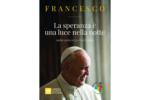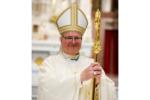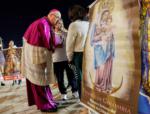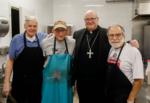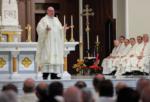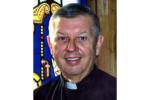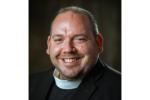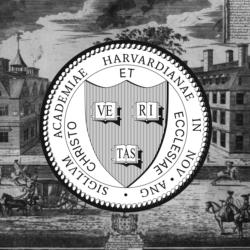Thousands of Maronites welcome St. Charbel's relics to new Australian home
SYDNEY (OSV News) -- Thousands of Maronite Catholics shut down the streets of the Sydney suburb of Punchbowl to welcome relics of Lebanon's most well-known saint to their new permanent home in Australia.
Queues of faithful braced the rain May 8 along the avenue where St. Charbel's Church and Monastery stands, spilling over onto neighboring streets as more than 70 white-clad pallbearers carried a 242-pound replica of St. Charbel's tomb atop a bed of 2,500 roses. The glass-topped tomb held a first-class relic -- a bone of St. Charbel's -- and a replica of his body dressed in a cassock he had worn.
Beginning at the Punchbowl train station, old and young, families and friends processed for more than half a mile alongside the tomb for nearly an hour and a half.
They sang hymns and prayed the rosary until reaching the tomb's final resting place at the parish, which is celebrating its 50th jubilee year as well as the saint's birthday.
Locals lit candles in their front yards and street lights were dimmed for the procession led by a marching band and four men carrying grand-sized incense burners.
Parents raised children on their shoulders and the crowd moved in tighter to witness the tomb arrive at what is now only the second shrine in the world dedicated to the Lebanese saint.
Born Youssef Antoun Makhlouf May 8, 1828, St. Charbel was a Maronite monk and priest who lived as a hermit from 1875 until his death Dec. 24, 1898. During his life, he obtained a wide reputation for holiness and for his ability to unite Christians, Muslims and Druze.
He is known among Lebanese Christians as the "Miracle Monk of Lebanon" because of the favors received through his intercession, especially after prayers are said at his tomb in the Monastery of St. Maron in Annaya, Lebanon. He was beatified in 1965 and canonized in 1977 by St. Paul VI.
The arrival of the replica of his tomb from Lebanon, made of the same rosewood timber of the original coffin and designed by the same artist, now establishes the parish as a significant Australian pilgrimage site for Catholics worldwide.
Following the procession, Maronite Bishop Antoine-Charbel Tarabay of Australia, New Zealand and Oceania, led the celebration of Mass with the visiting superior of the Monastery of Annaya in Lebanon, St. Charbel's parish superior Abbot Tannous Nehme, Father Assaad Lahoud and other monks as well as priests from Sydney's Maronite parishes.
"I have been a priest for 31 years and a bishop for 11 years. Tonight, I am speechless. Thank you Lord, thank you St. Charbel, thank you to the Lebanese Maronite Order of monks," Bishop Tarabay said.
Calling it "a day to remember" in the life of the southwest Sydney parish and wider Australian Maronite community, the bishop said the saint's birthday procession served as a public testament to "the faith of the church, to your faith, and to the faith of St. Charbel in God.""Now, with the presence of Annaya's spirituality here in Punchbowl, we are reminded of the strong ties we hold to our heritage and homeland," he said.
"The monks who arrived from Lebanon (50 years ago), armed with nothing but a vision and a devotion to spread the monastic charism and love for St. Charbel in this distant land, have become pillars of our eparchy," the bishop continued. "Their dedication has helped shape and build the spiritual foundation for future generations.
"It would be no exaggeration to say that we stand on the shoulders of giants -- those who arrived with nothing yet left us with an enduring legacy."
"Indeed," Bishop Tarabay said, "St. Charbel is not merely a saint for a particular people or creed; he is a beacon of faith for all humanity. His miraculous deeds serve as a testament to the power of faith and the boundless love of our Creator."
Norman Bejjani, one of the organizers of the procession, told The Catholic Weekly, Sydney's Catholic newspaper, that practicing for the large-scale event involved some trial and error.
From last minute complications with the pallbearers' robes and continuous adjustments to the coffin's enormous float, he said months of preparation paid off on a night which touched the hearts of everyone involved.
"Five hours before the event I received a call from a man who was desperate to be a pallbearer but hadn't known what was happening until very late. Everything, including backup carriers had been prepared for weeks, but I said if someone didn't turn up I would let him know," Bejjani said.
"Low and behold, one person didn't come. This man took his spot and was in tears as he carried the tomb down the street," he said. "It shows that it's not about what we're doing, but about who we're doing it for. These public processions show that Catholics are here, consolidated and strong."
Pallbearer and St. Charbel's parishioner Daniel Merhi signed on for the task immediately despite the threat of, and eventual, rain, which he said only added to the atmosphere."For the Maronite community, I hope this occasion enriches our faith. I'm sure there are many here who are not cemented in their faith as much as they would like, but such a great witness like this can really turn the tide for people," he said.
"On the other hand, for those who don't really know anything about the faith, this is an example of the kind of community and spirit we have together, not just as Maronites but humanity itself," he added.Frank Nader, who recently married at St. Charbel's Church and has grown up there, said it was a truly historic event.
"For this to be so close to home is unthinkable, I couldn't have imagined it," he said. "Instead of traveling 20 hours on a flight to Lebanon, St. Charbel is now a 20-minute drive to the parish we hold so dear in our hearts."
- - - George Al-Akiki is a journalist at The Catholic Weekly.

